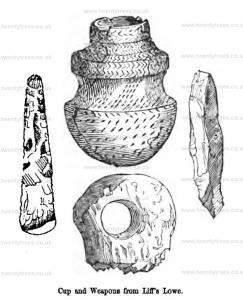Ten Years' Digging Observations on Celtic Pottery
Ten Years' Digging Observations on Celtic Pottery is in Ten Years' Digging.
Our experience in barrow-digging will justify the statementi that all the vessels exhumed from Celtic Tumuli may be arranged in one of four classes, which are —
I Cinerary or Sepulchral XJents — such as have either contained, or been inverted over, calcined human bones, and which alone are correctly styled Urns.
II Incense Cups — so called, though their real purpose is doubtful. Diminutive vessels, only found with calcined bones, and frequently enclosed in urns of the first class.
III Small Vases — probably intended to contain an offering of food; usually found with unbumt bodies but not imfrequently with burnt bones, though never containing them.
IV. Drinking Cups — tall and highly-ornamented vessels, constricted in the middle, and no doubt named in accordance with their use, by Sir R. C. Hoare.
Most of the woodcuts here introduced have been used in the former volume, but it is hoped that the repetition will be excused on the ground of the assistance they afford for clearly under* standing the varieties, which it would be diflScult to describe by words alone, without the help of diagrams.
Cinerary urns, being found in tumuli both of the earlier and later Celtic period, exhibit considerable variation in rize, paste, and ornamentation. Those presumed, from their containing silicious weapons, to be the most ancient, are generally large, from ten to sixteen inches high, with a deep border, more or less decorated by impressions of twisted thongs, and incised patterns in which the chevron or herring-bone constantly recurs in various combinations occaaionally relieved by circular punctures, or assuming a reticulated appearance. We believe that no piece of Celtic pottery hitherto discovered, shows the slightest indication of an attempt to imitate any natural form, though the contrary is the case in the fictilia of most other savage nations. The paste of the older vessels consists of clay, mixed with pebbles or angular pieces of gravel; and being wholly wrought by hand, without the assistance of the wheel, is in large vessels necessarily thick, and from the imperfect method of firing has often been described as merely "sun-dried " — a mistake very evident to all practically acquainted with the readiness with which clay so hardened imbibes moisture and returns to its original imctuous state. These urns are mostly of a brown or burnt mnber colour outside, though occasionally of a lighter tint: inside they are always blacky and often show marks indicating that their contents were deposited in a glowing state. The fracture shows the dark colour to extend through the paste very nearly to the outside. It is only in rare instances that instruments of bronze have been found with the more ancient urns. The example chosen as a tjrpe of this variety was found near Middleton by Youlgrave, in 1846; it measures fourteen inches in height.

Cinerary urns from the Yorkshire barrows are, in some instancesi more elegant in shape, taller in proportion to the diameter, and have the inside of the border ornamented, a feature never found in any of the older Derbyshire or Staffordshire urns. It would appear that a considerable interval elapsed, in which burial by inhumation was in vogue, before a return to combustion rendered cinerary urus again requisite, and in the meantime some improvement had taken place in the» ceramic art. We find the urns much smaller, from five and a half to nine inches high, still with the overhanging border which seems characteristic of cinerary urns. A reticulated pattern seems almost to have supplanted the chevron; the clay is mixed with coarse sand instead of pebbles, to prevent its cracking; the substance is thinner, and being more firmly baked, shows a lighter colour, varying from a red to a yellow brown outside; the paste and inside dark grey. It will be evident that the bones must have been more perfectly burnt than before, to enable them to be enclosed in such small vessels. The illustration, in which the lower figure represents an incense cup, is from an urn 5¼ inches high, found on Stanton Moor, Derbyshire, in 1799.

Urns of a still later period, occasionally found as secondary deposits in some of our barrows, are palpable imitations of the conunon globular urn of the Romano^British period, both in form and materiaL There are two varieties. One of clumsy shape, modelled by hand from clay containing an unusual quantity of sand, and pretty well baked, often presents, besides the narrowed mouth distinctive of late pottery^ and never seen in the archaic, another peculiarity in having occasionally a couple of perforations about an inch apart at the side. This form merges, by insensible gradations, into that of the Teutonic pottery sometimes found in connderable quantity in the cemeteries of Nottinghamshire asd Lincolnshire. The other variety is a close and well-made imitation of the Roman urn, in day mixed with angular fragments of quartz, turned on the wheel, and firmly baked to what may literally be denominated pot metal. The outer surface is rather rough, owing to the angular fragments of stone; its colour a bluish grey, the inside more or less red, and the paste mostly grey. Coins of the Lower Empire, chiefly of the family of Constantine the Great, have been found in connection with these urns.
The second class includes all varieties of the small vessels called incense cups, the tise of which is not satisfectorily decided. They differ greatly in shape, but agree in being very small, seldom three inches high, more usually one and a half or two. They are found with calcined bones only, most frequently within larger urns, though occasionally with bones that have not been inumed, and are much more plentiful in Yorkshire than in other coimties. There is reason to suppose that they do not accompany the earliest interments. From their small size, they are generally found in good condition. The oldest resemble the urns in their style of ornament, which is generally incised, and not pressed in by twisted cords. They have also, in many cases, two perforations at the side; rarely, two at opposite sides, as if for suspension. A later variety, generally very firmly baked, is quite plain, with the upper edge turned in towards the mouth, presenting a depressed outline oflen resembling a fiattened sphere. The paste is generally less mixed with pebbles or sand than that of the larger ves- selsi as there was not so much risk of their cracking whilst being fired. They are also lighter in colour, firom being more perfectly baked. The woodcut represents a cup found inside a cinerary urn on Baslow Moor, Derbyshire, about 1830.

The third division, comprising the vases for food, includes vessels of every style of ornament, from the rudest to the most elaborate, but nearly alike in size, and more difficult to assign to a determinate period than any other, from the fact of a coarse and a well-finished one having several times been found in company. They occur both with skeletons and burnt bones; perhaps more firequendy with the former, where they are often found near the head. Where two have been found, it has generally been with burnt bones, and probably indicates the combustion of two bodies. The woodcuts show two found in the barrow on the circle at Arbor Low [Map], in 1845, with a ground plan of the cist indicating their position.
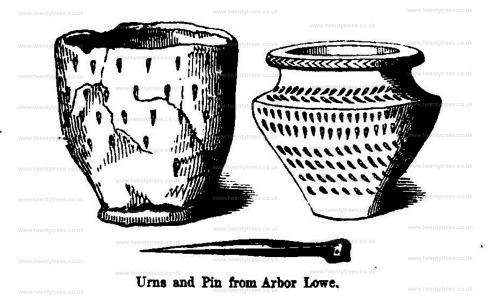
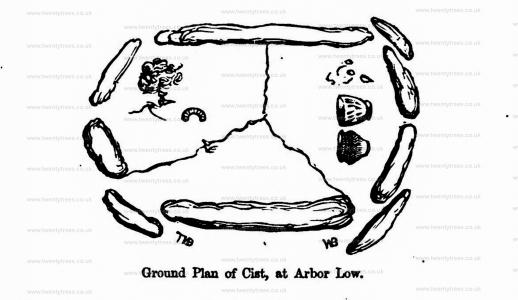
They yary from 4½ to 5½ inches in height, and have generally a wide mouth and a small bottom. They are composed of clay very similar to that used in the cinerary urns, and are pretty much of the same colour, though on the whole a shade lighter. The plainer specimens are ornamented by incised lines, disposed herring-bone fashion round the upper part, which is generally moulded with a simple hollow, the decoration extending to the edge; sometimes the whole of the outside is marked by the end of the finger. A good average specimen of the plain variety is represented in the cut; it was found at Crosslow [Map], Derbyshire, in 1843.
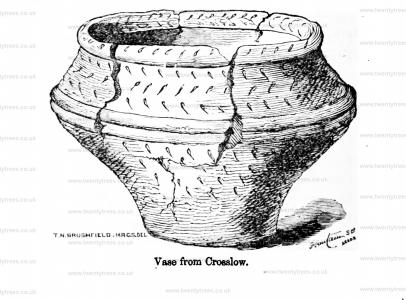
A more highly-finished type is constantly found both in Derbyshire and Yorkshire, which differs from the foregoing, in having a groove round the upper part, in which are four stops or projecting pieces of clay, often pierced in the direction of the groove with a small hole just sufficient to receive a thin cord. They are carefully ornamented all over with impressions from a toothed instrument, a tightly twisted cord, and circular punctures, sometimes separately, sometimes in combination. One found in Yorkshire, at Newton-upon-Rawcliff, in 1850, has a singular onjament in the shape of a cross, formed by rows of punctures carefully impressed outside the bottom; and an example altogether unique in shape and decoration, found on Wetton Hill, Staffordshire, in 1849, has the stops developed into small handles or ears. The last class is devoted to a series of vessels, happily denominated Drinking Cups, by Sir R. C. Hoare, who discovered several fine specimens in the course of his extensive researches in Wiltshire. They have been plentifully found in Derbyshire and Staffordshire, but only at rare intervals in Yorkshire. We have always found them associated with skeletons accompanied by flint weapons of a superior description, when they occupy a situation behind the f shoulders. In one or two instances a very small bronze awl has I been found, but there is sufficient evidence to show that they belong to a period when metal was almost unknown. They are from 6½ to 9 inches high, of a tall shape, contracted in the middle, globular below, and expanding at the mouth: they are carefully formed by hand, of fine clay, tempered with sharp sand, and well- baked; the walls are thin, averaging about ⅜th's of an inch, light red-brown outside, and grey within. The exterior is almost always covered with an elaborate pattern, produced by a toothed instrument: in two instances only we have seen it confined to a number of parallel lines encircling the upper part. The cut pre- sents a fair example of this vessel, which does not vary so much as the other classes: it was found at Green Low, on Alsop Moor, Derbyshire, in 1845.
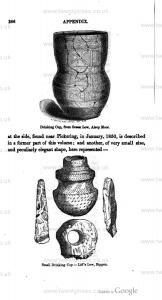
Two aberrant varieties have been observed, a single specimen of each having occurred. One, furnished with a handle or loop at the side, found near Pickering, in January, 1850, is described in a former part of this volume; and another, of very small size, and peculiarly elegant shape, here represented was found with an assemblage of beautiful flint weapons, behind the shoulders of a skeleton, near Biggen, Derbyshire, in 1843. It is only from the circumstances of discovery that we are enabled to identify it as a Drinking Cup, as it differs from all others that we have seen.
It is remarkable that the usual shape of these vessels is analo- gous to that of a series of larger vases of the earliest Greek drab- coloured ware, to be seen in the Vase-Room at the British Museum: the geometrical ornament, too, offers many points of resemblance, although produced by brown pigment on the Greek, and incised upon the Celtic earthenware.
